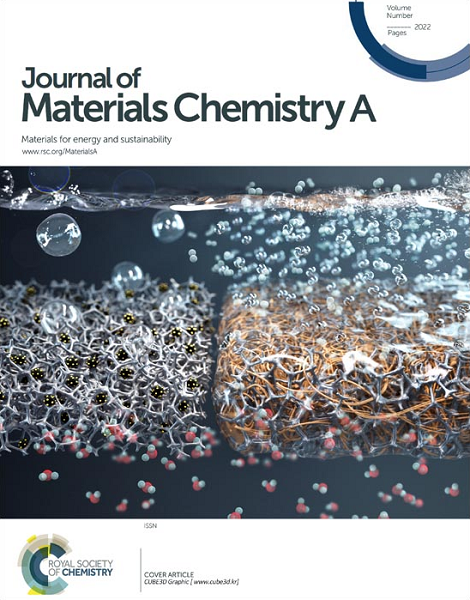高性能钒氧化还原液流电池用单宁酸辅助铋纳米颗粒在碳毡表面的包覆
IF 9.5
2区 材料科学
Q1 CHEMISTRY, PHYSICAL
引用次数: 0
摘要
在电极表面沉积金属催化纳米颗粒,实现卓越的催化能力和强大的机械化学稳定性,对于提高高性能液流电池技术的商业可行性至关重要。在这里,我们提出了一种通过单宁酸辅助鲁棒固定的铋纳米粒子(Bi NPs)包裹的碳毡电极,该电极可以高效催化V 2 + /V³+的氧化还原反应,并且具有优异的耐久性。单宁酸中的羟基充当多齿配体,与铋离子配合,在碳热反应中产生的Bi NPs周围形成异常稳定的保护框架。这些嵌入的Bi NPs在电解质流动下保存良好,优于通过单一碳热还原或电沉积方法制备的Bi NPs电极。结果表明,在电流密度为300 mA cm⁻²和400 mA cm⁻²时,采用该电极的vrfb的能量效率分别为77.68%和72.11%,比采用原始碳毡的vrfb的能量效率分别提高了4.90%和8.53%。此外,在400毫安厘米(⁻²)时,放电容量增加了136%。此外,新型结构的催化电极使vrfb即使在300 mA cm - 2下循环2000次后也能保持高性能,表现出99.97%的能量效率保持率和0.014%的放电容量衰减率。本文章由计算机程序翻译,如有差异,请以英文原文为准。
Tannic Acid-Assisted Surface Encasing of Bismuth Nanoparticle on Carbon Felt for High-Performance Vanadium Redox Flow Batteries
Achieving superior catalytic ability and robust mechanochemical stability in metal-catalyzed nanoparticles deposited on electrode surfaces is essential for advancing the commercial viability of high-performance flow battery technologies. Herein, we propose a type of carbon felt electrode surface encased with bismuth nanoparticles (Bi NPs) via a tannic acid-assisted robust immobilization, which can catalyze the V²⁺/V³⁺ redox reaction with high efficiency and outstanding durability. The hydroxyl groups in tannic acid serve as polydentate ligands, coordinating with bismuth ions to form an exceptionally stable protective framework around the Bi NPs generated during carbothermic reactions. These enchased Bi NPs are well-preserved under electrolyte flow, surpassing that of Bi NPs electrodes fabricated via single carbothermic reduction or electrodeposition methods. The results demonstrate that the VRFBs equipped with the present electrode achieve energy efficiencies of 77.68% and 72.11% at current densities of 300 mA cm⁻² and 400 mA cm⁻², which are remarkably increased by 4.90% and 8.53% than those of batteries integrated with pristine carbon felt. Furthermore, at 400 mA cm⁻², the discharge capacity increases by as much as 136%. Moreover, the novel structured catalytic electrodes enable the VRFBs to sustain high performance even after 2000 cycles at 300 mA cm⁻², exhibiting an energy efficiency retention rate of 99.97% and a discharge capacity decay rate of 0.014% per cycle.
求助全文
通过发布文献求助,成功后即可免费获取论文全文。
去求助
来源期刊

Journal of Materials Chemistry A
CHEMISTRY, PHYSICAL-ENERGY & FUELS
CiteScore
19.50
自引率
5.00%
发文量
1892
审稿时长
1.5 months
期刊介绍:
The Journal of Materials Chemistry A, B & C covers a wide range of high-quality studies in the field of materials chemistry, with each section focusing on specific applications of the materials studied. Journal of Materials Chemistry A emphasizes applications in energy and sustainability, including topics such as artificial photosynthesis, batteries, and fuel cells. Journal of Materials Chemistry B focuses on applications in biology and medicine, while Journal of Materials Chemistry C covers applications in optical, magnetic, and electronic devices. Example topic areas within the scope of Journal of Materials Chemistry A include catalysis, green/sustainable materials, sensors, and water treatment, among others.
 求助内容:
求助内容: 应助结果提醒方式:
应助结果提醒方式:


